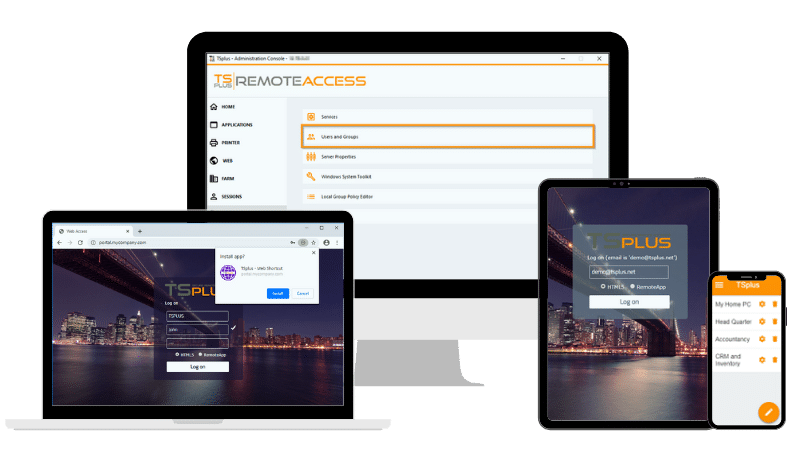)
)
Introduction
Remote work, hybrid IT environments, and bring-your-own-device (BYOD) trends have all amplified the need for robust and secure remote access solutions. While Windows 11 is gaining ground, Windows 10 remains a very highly used OS in professional environments across small and medium-sized businesses. Users and IT administrators need clarity on what Remote Desktop client (RDP) they should be using, especially with Microsoft’s ongoing shift toward Azure-based infrastructure. This article unpacks the latest Microsoft RDP client for Windows 10, highlights its evolution and introduces TSplus Remote Access as a powerful, cost-effective alternative that simplifies administration and enhances security.
What Is the Latest Microsoft RDP Client for Windows 10?
As of July 2025, the official and most up-to-date Microsoft Remote Desktop client for Windows 10 is Microsoft Remote Desktop client (MSRDC), version 1.2.4880. This client is part of the new generation of RDP tools designed to support Azure Virtual Desktop (AVD) and cloud-first infrastructure.
Why the Change?
Microsoft previously offered its Microsoft Remote Desktop app via the Microsoft Store (MSRDP). While still available for download, it has not received major updates in recent releases and is now considered a legacy solution.
The MSRDC client is the successor, offering enhanced performance, security features and compatibility with modern Windows Server builds and Azure environments. MSRDC is now the preferred tool for connecting to AVD, Windows 365 and hybrid remote infrastructures.
What are the Key Features of the Latest RDP Client for Windows 10?
The latest version of MSRDC includes several enterprise-grade enhancements. These reflect Microsoft's focus on performance, user experience and compatibility with evolving cloud-based IT systems.
Features include:
- Dynamic display scaling
- Multi-monitor support
- Device redirection
- RemoteFX compression and optimisation
- Persistent sessions
- Network Level Authentication (NLA) & TLS 1.2 encryption
- Seamless integration with Azure Virtual Desktop
Dynamic display scaling
Automatically adjusts resolution and scaling to match the window size and screen DPI of your local device. This ensures a seamless user experience whether you're switching between high-resolution monitors, laptops, or tablets, with no need for manual reconfiguration.
Multi-monitor support
Allows users to extend or duplicate remote desktop sessions across two or more screens. This is especially beneficial for professionals in IT, finance, design, or engineering who rely on multitasking and large screen real estate.
Device redirection
Enables the use of local peripherals such as USB drives, printers, webcams, smart cards, and audio devices within the remote session. This creates a more native-like experience and facilitates tasks such as scanning documents or authenticating with security tokens.
RemoteFX compression and optimisation
Utilizes advanced video compression and intelligent encoding to deliver smoother graphical performance even over limited or fluctuating bandwidth connections. Ideal for remote work scenarios where internet speed is not always guaranteed.
Persistent sessions
Maintains active applications and session states even when the user disconnects or experiences brief connectivity loss. Upon reconnection, users can resume exactly where they left off, saving time and avoiding data loss.
Network Level Authentication (NLA) & TLS 1.2 encryption
Secures remote desktop sessions through pre-authentication and encrypted communication. This minimizes the risk of unauthorized access and ensures compliance with modern cybersecurity standards .
Seamless integration with Azure Virtual Desktop
Built to work flawlessly with Azure Virtual Desktop environments. Users benefit from centralised management, dynamic scaling and single sign-on capabilities, all of which are critical for enterprise IT teams leveraging Microsoft’s cloud infrastructure.
How compatible and available is the MSRDC client?
The MSRDC client supports:
- Windows 10 (64-bit, 32-bit, and ARM64 architectures): including all professional and enterprise editions still in mainstream support.
- Windows 11 (Home, Pro, Enterprise, Education): full compatibility with all feature updates.
- Windows Server 2016, 2019 and 2022: including integration with Remote Desktop Services (RDS) roles.
- Azure Virtual Desktop (AVD): fully optimized for cloud-hosted desktops and virtual apps.
- Windows 365 Cloud PC: seamless access to persistent, cloud-based Windows environments.
This broad compatibility allows businesses using modern infrastructures to deploy MSRDC across both cloud-based and on-premises scenarios, offering consistent user experience and access performance.
Microsoft delivers the MSRDC client via the Microsoft Download Center and it is also maintained through Windows Update for Business and Microsoft Endpoint Manager. These update channels ensure the client remains secure, regularly patched and aligned with the latest Microsoft policies and features.
In enterprise environments, IT administrators can also deploy MSRDC using Group Policy Objects (GPO) Intune or PowerShell automation, making it suitable for large-scale rollouts.
Important: One critical caveat: MSRDC is not backward-compatible with Windows 7 or older operating systems. That means if your organization still runs legacy applications or infrastructure on Windows 7, XP or Server 2008, the MSRDC client will not function properly.
Why Microsoft’s Direction May Not Fit All Use Cases?
While the MSRDC client is a robust and feature-rich tool, it is clearly engineered to support Microsoft’s cloud-first strategy, with strong emphasis on Azure Virtual Desktop (AVD) and Windows 365 environments. For enterprises already fully integrated into the Azure ecosystem, this alignment makes perfect sense. However, for many other organizations, especially those with more traditional or hybrid IT infrastructures, the approach introduces practical limitations.
Common Challenges for Traditional IT Environments:
- High licensing and infrastructure costs: Azure-based virtual machines and associated cloud services can become prohibitively expensive, particularly for small and mid-sized businesses operating on fixed budgets.
- Steep learning curve for administrators: Setting up and managing AVD or Windows 365 environments requires advanced knowledge of Microsoft cloud tools, Azure Active Directory, security groups and policy management. This may demand dedicated IT resources or costly third-party consultants.
- Limited flexibility in application delivery: While MSRDC integrates well with Microsoft's offerings, it doesn’t offer the same level of granular control or simplicity for publishing individual applications, especially outside Azure.
- No built-in HTML5 web access: Unlike third-party RDP solutions, the MSRDC client does not include a native browser-based access option unless integrated with Azure Virtual Desktop. This restricts browser access to environments already committed to the Azure stack.
As a result, small and mid-sized businesses, educational institutions, and legacy-dependent sectors (like healthcare or manufacturing) often find Microsoft’s solution too complex or costly for their needs. For organizations where cost efficiency, fast deployment and support for older systems are critical, a more streamlined and adaptable solution becomes essential.
Introducing TSplus Remote Access: Why Can it Be a Better Fit for Many Businesses?
TSplus Remote Access was developed to solve these specific challenges, offering an affordable, secure and easy-to-deploy remote desktop solution for businesses that want more control and less complexity.
TSplus brings the benefits of remote work to Windows 10, Windows 7 and Server environments alike, without needing to shift to Azure or replace existing infrastructure.
What are the Key Features of TSplus Remote Access?
TSplus focuses on simplicity and flexibility, thus providing organizations with a complete remote access toolkit that’s easy to configure and scale. The key features of TSplus Remote Access are the following:
- HTML5 Web Access
- Advanced Security
- Universal Printing
- Application Publishing
- Precise Role & Access Control
- Multi-Tenant & Scalable Farms
HTML5 Web Access
No installation or configuration is required on the client’s side. Users can initiate secure remote sessions directly from any modern web browser (including Chrome, Firefox, Safari and Edge) on desktops, laptops, tablets or smartphones. This ensures universal accessibility across platforms without the need for proprietary software.
Advanced Security
TSplus includes a comprehensive suite of built-in security features such as two-factor authentication (2FA), SSL/TLS encryption, brute-force attack prevention, IP filtering and endpoint access rules. For organizations with higher security demands, the optional TSplus Advanced Security add-on delivers proactive protection, auditing tools and compliance support.
Universal Printing
Remote printing is made effortless with TSplus. Users can print documents from remote applications directly to their local printers, without installing special drivers. The integrated Universal Printer and Virtual Printer ensure compatibility with a wide range of devices and printing environments whether on-premises or cloud-based.
Application Publishing
Administrators can choose to publish individual applications instead of full remote desktops. This improves security, simplifies the user interface and reduces bandwidth consumption. Ideal for focused access to software such as CRMs, accounting tools or industry-specific applications, without overwhelming end-users.
Precise Role & Access Control
TSplus offers granular control over what each user or group can see and do. You can define access to specific applications, desktops, or file systems based on user roles or organisational structure. The system supports integration with Active Directory, Azure AD and local user accounts, making user management both flexible and scalable.
Multi-Tenant & Scalable Farms
Built with scalability in mind, TSplus supports advanced multi-server architecture. Administrators can configure load balancing, reverse proxy settings and session prelaunch to distribute traffic efficiently and minimize wait times. This ensures consistent performance, even for large teams or remote user bases distributed across different locations.
Why Choose TSplus Over Native RDP?
Unlike Microsoft's offering, which increasingly requires integration with Azure or cloud subscriptions, TSplus is designed to run in the cloud, on-premises or hybrid. You stay in full control of your servers, apps and users.
TSplus enables remote access within hours, not days. The intuitive admin console removes the need for deep Windows Server or Azure expertise. This means faster deployment, easier support, and fewer headaches for your IT team.
Why TSplus Can Cover You for Legacy Systems?
One major limitation of MSRDC is that it does not support Windows 7, which is a problem for companies still running legacy software or hardware. TSplus, however, continues to support:
- Windows 7
- Windows 8.1
- Windows Server 2008/2012
- Hybrid environments with older and newer OS versions
This makes TSplus the most flexible remote access solution for industries with legacy constraints, such as manufacturing, legal, healthcare and government.
Conclusion
Microsoft’s latest RDP client for Windows 10 (version 1.2.4880) provides impressive capabilities, especially when paired with Azure services. However, it also introduces cost and complexity that may not suit all environments. For IT managers, CIOs and SMB owners looking for secure, scalable and budget-friendly remote access, TSplus Remote Access is a perfect fit. It delivers enterprise-grade functionality with none of the licensing headaches and works even on legacy systems like Windows 7.

TSplus Remote Access Free Trial
Ultimate Citrix/RDS alternative for desktop/app access. Secure, cost-effective, on-premises/cloud














)
)
)